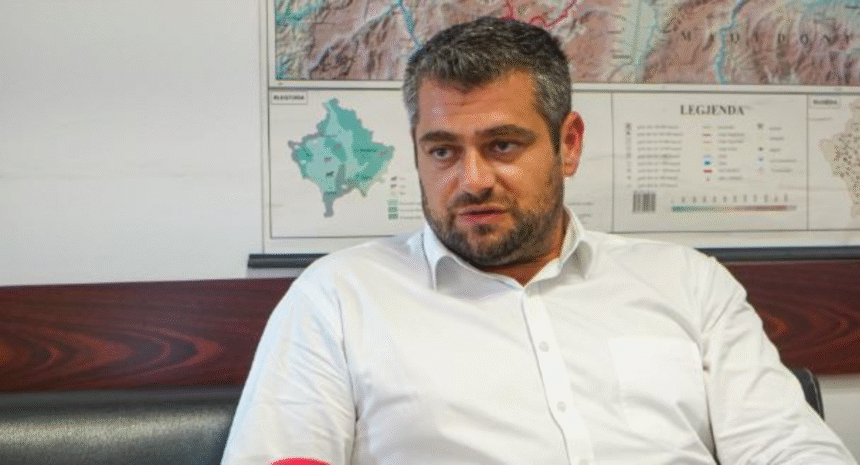The head of the Government Commission on Missing Persons, Andin Hoti, welcomed but also criticized as overdue the news of the issuance of an arrest warrant for Milan Radoičić.
The Basic Court in Pristina has issued an arrest warrant for Milan Radoičić, the main suspect in the Banjska terrorist attack, charging him with “war crimes against the civilian population.” He is among 20 Serbs for whom arrest warrants have been issued, suspected of killing 106 Albanian civilians in Gjakova in May 1999.
“I believe we are late. Of course, it is a very good initiative. But there are hundreds, even thousands of criminals like Radoičić and others who are accused today, who have committed the most heinous crimes and still roam free. There are known individuals who hid human remains. For example, there are names of people who took my father from a high-security institution the prison and they are still free in Belgrade,” Hoti said on KTV’s “60 Minutes.”
He emphasized that although such initiatives are welcome, they come too late, and he pointed out that some criminals have even been released shortly after their arrest.
Hoti noted that there are currently 1,588 persons still forcibly missing from the Kosovo war. He said efforts are underway to resume excavations in Batajnica, but the Serbian side continues to obstruct the process.
He expressed hope that the new EU envoy for Kosovo-Serbia dialogue, Peter Sørensen, will prioritize the issue of missing persons.
“So far this year, we have conducted four excavations in Kosovo territory. We have at least 11 more planned. The biggest challenge remains access to locations in Serbia, where there is a complete blockade. Most of the missing persons are believed to be in Serbian territory… We have discussed Batajnica with the Serbian delegation in working groups and also in Brussels. We have requested to return to Batajnica. Batajnica, along with Petrovo Selo and Perućac, were sites investigated in 2000-2002. No excavations have taken place there for 22-23 years. For two years, we have continuously requested to return to Batajnica, but unfortunately, the Serbian side postponed it again last year without giving sufficient explanation,” Hoti said.
Hoti added that the European Union has neither sanctioned nor criticized Serbia for boycotting the January 15 meeting of the Joint Commission. He also said that Serbia cut off cooperation even at the expert level as of January 31.
Regarding Sørensen, Hoti said his first impressions were positive.
“The fact that Mr. Sørensen, during his first visit to Kosovo, met not only with leaders but also with me as the head of the Commission, shows he prioritizes the issue of missing persons. Sørensen spent six years in Kosovo after the war and knows the situation well. He said that one of his main priorities would be the issue of the missing. I don’t want to accuse anyone, but Mr. Miroslav Lajčák never once met with the head of the Commission during his visits to Kosovo, nor did he prioritize the missing persons issue, whereas I saw this immediately with Sørensen,” said Hoti.
Hoti also mentioned ongoing insistence in Brussels that Serbia must open its archives.
He explained that under the Brussels Agreement, the use of LIDAR technology, which scans the ground from the air, was foreseen. He noted that while scanning was conducted both in Kosovo and Serbia, only Kosovo has so far produced a report on its findings, while Serbia has not.
Based on the LIDAR scans, Kosovo has investigated four locations so far this year, with three more (Dragodan, Istog, and Podujeva) currently in the treatment phase.
“LIDAR revealed anomalies, and those areas must be excavated. We have at least 11 upcoming locations to complete within the next three to four months,” Hoti said.
Andin Hoti also stated that they have started re-identifying remains using DNA methods in some cases where previous identifications, done without DNA (based on clothing or personal documents), might have been wrong.
He added that the Dubrava Prison Massacre is also being addressed, with family members being asked to provide blood samples.
“I don’t want people to think everything was done wrong, but where there are doubts, they must be clarified. Traditional identification — meaning based on clothes, IDs, watches, or presumed recognition — happened between 1999-2002. Since 2003, identifications are done scientifically through DNA. It doesn’t mean all previous identifications were wrong, and we are not forcing families; we are selecting based on information. We only ask for one drop of blood. Through blood, we can match it with existing morgue samples. There are about 300 unidentified remains at the morgue. If mistakes are found, we will notify the families and go through the appropriate procedures. Thankfully, the families have been understanding, and there is little resistance,” concluded Hoti.







